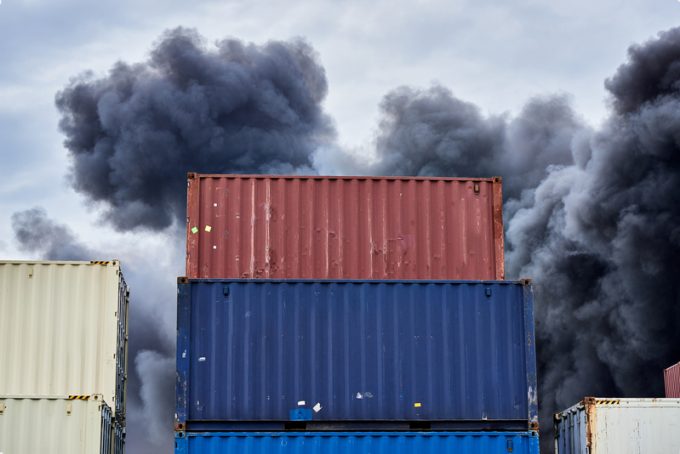Maersk Frankfurt heads for open water as container fire subsides
Maersk Frankfurt, the newbuild box ship that suffered a possible electrical fault and subsequent container ...
TFII: SOLID AS USUALMAERSK: WEAKENINGF: FALLING OFF A CLIFFAAPL: 'BOTTLENECK IN MAINLAND CHINA'AAPL: CHINA TRENDSDHL: GROWTH CAPEXR: ANOTHER SOLID DELIVERYMFT: HERE COMES THE FALLDSV: LOOK AT SCHENKER PERFORMANCEUPS: A WAVE OF DOWNGRADES DSV: BARGAIN BINKNX: EARNINGS OUTODFL: RISING AND FALLING AND THEN RISING
TFII: SOLID AS USUALMAERSK: WEAKENINGF: FALLING OFF A CLIFFAAPL: 'BOTTLENECK IN MAINLAND CHINA'AAPL: CHINA TRENDSDHL: GROWTH CAPEXR: ANOTHER SOLID DELIVERYMFT: HERE COMES THE FALLDSV: LOOK AT SCHENKER PERFORMANCEUPS: A WAVE OF DOWNGRADES DSV: BARGAIN BINKNX: EARNINGS OUTODFL: RISING AND FALLING AND THEN RISING

Stuart Edmonston, director, loss prevention at Thomas Miller P&I Ltd, will be the opening speaker at The Nautical Institute’s conference: Fires on Containerships. Here he examines some of the changes being implemented by the industry to avoid the human and financial costs of fires onboard ships, and takes a look at what is needed in the future.
As years go by, serious incidents caused by or involving dangerous goods continue to occur, not only on ships but also in ports. Errors, misunderstandings, misdeclarations and inadequate packing and securing lie at the heart of many of these incidents.
As ultra-large containerships increase in size, the potential for human, economic and environmental accidents rise in proportion.
Today The Loadstar reports that it has been confirmed that a fire which broke out aboard the Zim Kingston was caused by a container collapse that damaged boxes containing dangerous cargo. Fortunately none of the crew was hurt.
The tragic loss of five crew members when the Maersk Honam caught fire on 6 March 2018, led to CINS* (the Cargo Incident Notification System) publishing new safety guidance entitled Safety Considerations for Ship Operators Related to Risk-Based Stowage of Dangerous Goods on Containerships, which was prepared by a working group comprising CINS members, classification societies, a flag state and the International Group of P&I clubs.
The guidelines are intended to help improve fire safety onboard containerships. However, importantly, for the guidance to work it relies heavily on shippers filing accurate cargo declarations in the first place. The new guidance does not replace the SOLAS and IMDG requirements for stowage and segregation, it enhances the requirements of these regulations.
One of the biggest obstacles to progress is that the root cause of these incidents starts ashore, with the packing of the cargo and its stowage inside containers. Historically, stowage of cargo was carried out by the chief officer, who was fully trained and understood dangerous goods (DG) cargo, its hazards and how to stow it safely and effectively onboard.
Those who pack containers today often do not have the time, motivation or access to information to know how to pack a container correctly. There is also a lack of communication and transparency within the supply chain, and the sheer number of parties involved also contributes to the complexity of the problem.
There is a tendency for the industry and its representative bodies, such as the IMO, to be reactive following an incident, but what is needed is a proactive attitude and a change of approach to how we do things. We should also bear in mind that DG classification and regulations are complex and open to different interpretations.
When you look at the volume of hazardous and non-hazardous flammable cargo onboard ultra-large crude carriers (ULCCs), the size of any fire onboard will be almost impossible to contain. However, there are steps that the sector can take.
By developing trust and transparency throughout the supply chain, the carrier can understand the cargo onboard ship. This can be further aided through the use of automated cargo screening and machine-learning to compare declarations.
Better use of DG compliance software will also help, but this will not prevent mis-declarations if some shippers continue to fraudulently declare dangerous cargo. However, if used correctly, software can play an important role in segregation, declaration and documentation requirements.
In fact, increasing the use of technology in general will be essential in the future and, if combined with increased inspections followed by enforcement of criminal liability for defaulters, should help to reduce the number of incidents.
Of course, we can’t expect to entirely eliminate onboard fires, but we can improve how we handle them. Additional guidance by class, with better firefighting designs, are necessary as there is widespread concern about the suitability of current firefighting systems onboard containerships. The fixed fire-fighting equipment for the cargo spaces of a large container vessel, as mandated by SOLAS, is generally insufficient to fight an extensive fire, particularly with the increasing size of these vessels.
The current DG classifications are too complex for the untrained person to understand; they are open to different interpretations and so need to be clearer and more straightforward, perhaps using modern technology, animations and infographics, to explain the issues.
On a more positive note, people are taking action to address the issue of onboard container fires. We need all stakeholders within the industry to work together, collaborating and sharing information and ideas.
We hope The Nautical Institute conference will help the industry at large to understand the extent of the problems and the solutions needed to make the transport of hazardous cargo within the global supply chain safer.
Fires on Container Ships Conference | HQS Wellington, London | 4 November 2021: click here for further details and to register.
*CINS was established in 2011 to share information on all cargo related incidents. Its aim is to:
Comment on this article